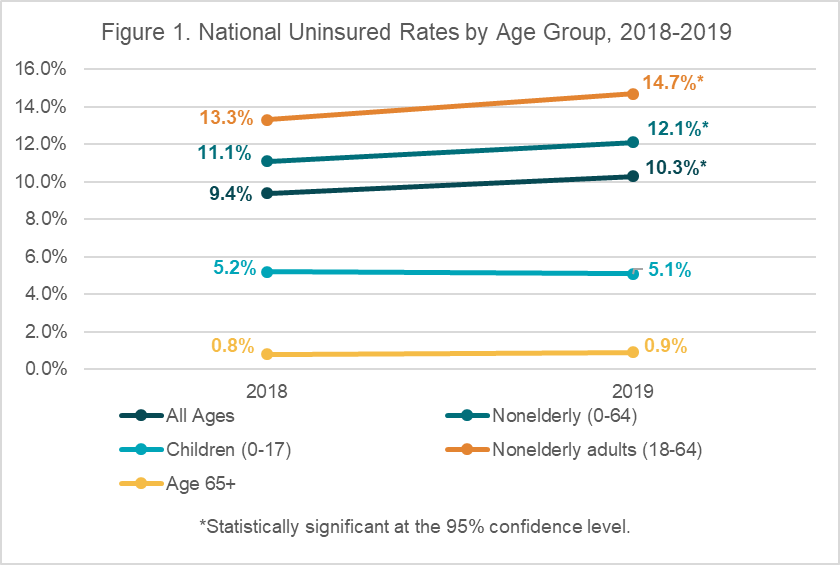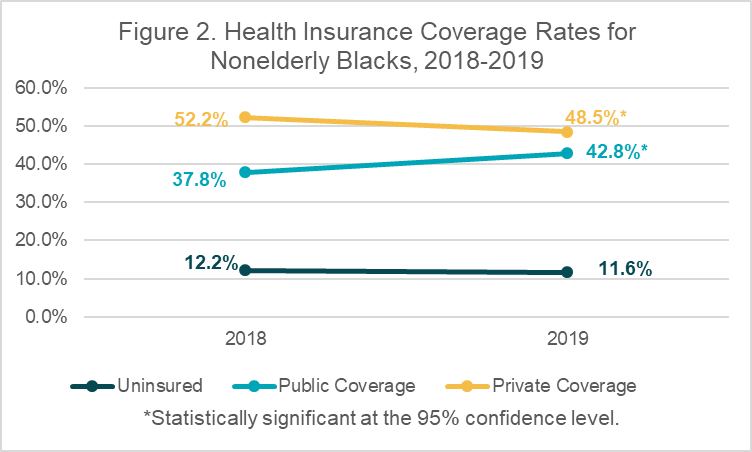Blog & News
2019 NHIS Full-Year Insurance Coverage Estimates Early Release: Uninsurance Increases, Variation among Public and Private Coverage
September 11, 2020:The National Center for Health Statistics (NCHS) released health insurance coverage estimates for 2019 from the National Health Interview Survey (NHIS) as part of the NHIS Early Release Program. These are both the first available full-year coverage estimates for 2019 from a federal survey as well as the first full-year estimates released since the NHIS questionnaire was redesigned and launched in January 2019—further details on which can be found at the end of this post.
National-level estimates are available by breakdowns including age group, sex, poverty status, race and ethnicity, and by state Medicaid expansion status. This is the first time that the NHIS full-year estimates have not included either full or partial state-level data.
More Americans without Health Insurance Coverage in 2019; Public Coverage Remained Steady and Private Coverage Fell among Certain Subgroups
The uninsured rate for all ages increased by 0.9 percentage points to 10.3% in 2019, up from 9.4% in 2018. This represents 33.2 million uninsured persons of all ages and is the first significant rise in the uninsured rate in several years as shown by the NHIS. Uninsured rates also increased from 2018 among all nonelderly persons (0-64) and nonelderly adults (19-64)—with the nonelderly rate rising 1.0 percentage points from 11.1% to 12.1% in 2019, and nonelderly adult rate increasing 1.4 percentage points from 13.3% to 14.7% in 2019.

Rates of public coverage were statistically unchanged across all age groups, while among nonelderly adults, rates of private coverage fell 2.1 percentage points in 2019 to 66.8% from 68.9% in 2018. Rates of uninsurance, private coverage, and public coverage were stable in 2019 for children (age 0-17).
More Black Americans had public coverage, fewer had private coverage; Uninsured rate increased among Whites*
Among the nonelderly population, the only racial/ethnic group that saw an increase in the uninsured rate were non-Hispanic Whites, whose rate increased to 9.0% in 2019 from 7.8%, a rise of 1.2 percentage points. Uninsured rates remained statistically unchanged for other racial/ethnic groups between 2018 and 2019.
One of the most significant findings in this category was a relatively large decrease in rates of private coverage of 3.7 percentage points among non-Hispanic Blacks, whose rate fell to 48.5% from 52.2% in 2018. Rates of private coverage were again statistically unchanged among other racial/ethnic groups.

Conversely, non-Hispanic Blacks experienced a large increase in rates of public coverage, which rose by 5.0 percentage points to 42.8% in 2019 from 37.8%. Rates of public coverage were statistically unchanged for other racial/ethnic groups.
More Women were Uninsured in 2019
The uninsured rate among nonelderly women increased to 11.0% in 2019, up from 10.0% in 2018, representing a 1.0 percentage-point increase. The uninsured rate among nonelderly men remained steady at 13.2%.
Uninsurance, Public and Private Coverage Rates See Similar Trends by State Medicaid Expansion Status
Across both those states that opted to expand Medicaid and those states that have yet to adopt Medicaid expansion, the nonelderly uninsured rate significantly increased in 2019 from 2018, rising to 9.1% from 8.3% (a 0.8 percentage-point increase) in expansion states and rising to 17.1% from 15.4% (a 1.7 percentage-point increase) in non-expansion states.
Though the year-over-year changes did not reach the specified threshold for statistical significance, both expansion and non-expansion states experienced possible erosions in rates of private coverage, with rates falling 1.4 percentage points to 65.0% in the former and falling 1.6 percentage points to 61.4% in the latter. Rates of public coverage experienced smaller, statistically insignificant changes in both categories of states.
Notes about the Estimates
*All subsequent category breakdowns (Race/Ethnicity, Sex, and Medicaid Expansion Status) encompass the nonelderly population, age 0-64.
The above estimates provide a point-in-time measure of health insurance coverage, indicating the percent of persons with that type of coverage at the time of the interview.
All changes described compare full-year 2018 to full-year 2019 and are statistically significant at the 95% confidence level unless otherwise specified.
2019 NHIS Redesign
The NHIS recently underwent a substantial redesign of its content and structure, the goals of which were to “improve the measurement of covered health topics, reduce respondent burden by shortening the length of the questionnaire, harmonize overlapping content with other federal health surveys, establish a long-term structure of ongoing and periodic topics, and incorporate advances in survey methodology and measurement.”[1]
One of the largest changes made under the redesign is the elimination of the family questionnaire, which previously asked questions about the family as a whole as well as separately of each member of the family. Most of the family questionnaire content was moved to revised sample adult and sample child questionnaires, which are asked of one adult and one selected at random from members of the household and has the effect of substantially reducing the available sample size. For example, the 2019 full-year early release report has a total sample of 32,391 persons, whereas the same report in 2018 was based on a sample size of 72,762 persons. However, NCHS anticipates that the redesign’s reduction in respondent burden will result in more sample adult and sample child interviews due to higher response rates.
[1] National Center for Health Statistics (NCHS). (2019, November 27). 2019 Questionnaire Redesign. Available from https://www.cdc.gov/nchs/nhis/2019_quest_redesign.htm
SHADAC Expertise
NATIONAL HEALTH INTERVIEW SURVEY
The National Health Interview Survey (NHIS) is an ongoing survey conducted throughout the year by the National Center for Health Statistics (NCHS) to monitor the health of the nation. It has been conducted since 1957. The NHIS data are collected through an in-person survey using computer-assisted personal interviewing (CAPI) in households. The target universe is the civilian noninstitutionalized population residing in the 50 states and District of Columbia.
The NHIS questionnaire was redesigned in 2019 and now consists of Sample Child and Sample Adult questionnaires that include questions from four content areas:
- Annual core (asked every year)
- Rotating core (asked in some but not all years),
- Sponsored content (topics of interest funded by other federal agencies or CDC centers)
- Emerging topics (newer topics of interest that have not been researched in the general population)
For 2016-2025, the NHIS sample design was expected to produce interviews from 27,000 Sample Adults and 9,000 Sample Children from about 35,000 households, though this varies by year. In 2022, the Sample Adult size was over 27,000, the Sample Child size was over 7,000 from nearly 29,000 households. The NHIS uses geographically clustered sampling techniques using a sampling plan based on the preceding decennial Census.
The sample for the NHIS represents the 50 states and the District of Columbia. However, the lowest level of geography available in the public-use data files is Census region. Restricted, state-level geography is available through the network of Research Data Centers. The household response rate is about 50 percent (Centers for Disease Control and Prevention 2022).
The NHIS asks the respondent about insurance status and coverage type at the time of the survey. This survey also asks if the respondent has been uninsured for at least part of the year prior to the interview and if the respondent has been uninsured for more than a year at the time of the interview. The question includes a comprehensive roll of insurance options that include public program names specific to the state in which the interview is conducted, as well as open-ended response options. A verification question is included to confirm that respondents who did not respond that they were enrolled in any insurance programs are, in fact, uninsured.









